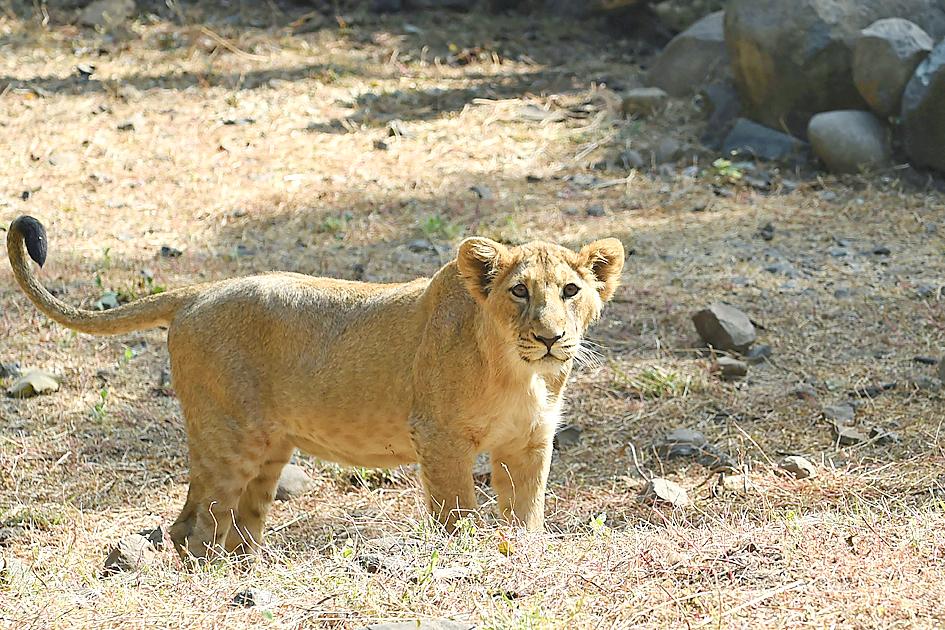Three years after a deadly virus struck India’s endangered Asiatic lions in their last remaining natural habitat, conservationists are hunting for new homes to help booming prides roam free.
The majestic big cats, slightly smaller than their African cousins and with a fold of skin along their bellies, were once found widely across southwest Asia.
Hunting and human encroachment saw the population plunge to just 20 by 1913, and the lions are now found only in a wildlife sanctuary in India’s western Gujarat State.

Photo: AFP
Following years of concerted government efforts, the lion population in Gir National Park has swelled to nearly 700, according to an official census last year.
However, just three years ago, the conservation success looked to be in danger when several lions started to die in one part of the 1,400km2 forest.
The canine distemper virus — a highly infectious disease — was detected among dozens of the royal beasts, killing at least 11 of them.
“We picked all the lions from the area and isolated them,” said Dushyant Vasavada, the park’s chief conservator of forests.
Authorities imported special vaccines from overseas and each animal was given three doses each, followed by a booster shot.
Cattle and dogs living near the park were also inoculated as suspected carriers of the virus.
“We vaccinated the lions in captivity and successfully controlled the disease, and no new outbreak has been observed,” Vasavada said, adding that park rangers were still closely monitoring their health.
Lions are a source of pride for India, particularly in Gujarat’s Saurashtra region, where man and beast coexist.
A cattle-rearing tribe lives among the animals in the sanctuary, and it is not uncommon to see a pride of lions crossing a highway in the region as motorists wait and watch.
The king of the jungle is also a major tourist attraction, along with leopards, panthers and other big cats in the sanctuary.
About 550,000 people visit the park each year, riding in open-top jeeps as they try to spot the predators prowling among pale yellow deciduous trees.
“It is a very thrilling experience to see the lions from close in the wild,” forest guide Dinesh Sadiya said.
The 2018 virus outbreak was a reminder that the steady growth in the animal’s population cannot be taken for granted.
The lions have low genetic diversity due to their small population size, making them more vulnerable to epidemics.
A 1993 outbreak of canine distemper virus in Tanzania’s Serengeti National Park killed one-third of its 3,000 lions.
Wildlife biologist Ravi Chellam said that outbreak underscored the need to move a few prides to other sites nearby.
“Translocation is a risk mitigation strategy akin to us getting health or life insurance,” he told reporters. “If something happens to the population in Gir, there is always going to be an additional free-ranging population of wild lions available.”
Chellam said that the sanctuary was also now too small for its steadily growing lion population.
“There are far more lions than what Gir can hold ... these animals are not static, they are constantly moving outside and interacting with domestic animals, and people,” he said.
Efforts to move some lions to other states have been mired in legal wrangles with the state government, which wants to keep the animals in Gujarat.
Authorities have instead proposed finding new homes for some lions in other parts of the state.

Republican US lawmakers on Friday criticized US President Joe Biden’s administration after sanctioned Chinese telecoms equipment giant Huawei unveiled a laptop this week powered by an Intel artificial intelligence (AI) chip. The US placed Huawei on a trade restriction list in 2019 for contravening Iran sanctions, part of a broader effort to hobble Beijing’s technological advances. Placement on the list means the company’s suppliers have to seek a special, difficult-to-obtain license before shipping to it. One such license, issued by then-US president Donald Trump’s administration, has allowed Intel to ship central processors to Huawei for use in laptops since 2020. China hardliners

A top Vietnamese property tycoon was on Thursday sentenced to death in one of the biggest corruption cases in history, with an estimated US$27 billion in damages. A panel of three hand-picked jurors and two judges rejected all defense arguments by Truong My Lan, chair of major developer Van Thinh Phat, who was found guilty of swindling cash from Saigon Commercial Bank (SCB) over a decade. “The defendant’s actions ... eroded people’s trust in the leadership of the [Communist] Party and state,” read the verdict at the trial in Ho Chi Minh City. After the five-week trial, 85 others were also sentenced on

Conjoined twins Lori and George Schappell, who pursued separate careers, interests and relationships during lives that defied medical expectations, died this month in Pennsylvania, funeral home officials said. They were 62. The twins, listed by Guinness World Records as the oldest living conjoined twins, died on April 7 at the Hospital of the University of Pennsylvania, obituaries posted by Leibensperger Funeral Homes of Hamburg said. The cause of death was not detailed. “When we were born, the doctors didn’t think we’d make 30, but we proved them wrong,” Lori said in an interview when they turned 50, the Philadelphia Inquirer reported. The

RAMPAGE: A Palestinian man was left dead after dozens of Israeli settlers searching for a missing 14-year-old boy stormed a village in the Israeli-occupied West Bank US President Joe Biden on Friday said he expected Iran to attack Israel “sooner, rather than later” and warned Tehran not to proceed. Asked by reporters about his message to Iran, Biden simply said: “Don’t,” underscoring Washington’s commitment to defend Israel. “We are devoted to the defense of Israel. We will support Israel. We will help defend Israel and Iran will not succeed,” he said. Biden said he would not divulge secure information, but said his expectation was that an attack could come “sooner, rather than later.” Israel braced on Friday for an attack by Iran or its proxies as warnings grew of